
Did you know that saying the “Om” mantra for 10 minutes a day can help a lot? It can lower stress, anxiety, and depression. It also improves focus, mood, and feeling connected to others. Mantra meditation has been a key part of Indian, Tibetan, and Asian spiritual traditions for centuries. It’s a powerful way to find inner peace and improve mental health.
Key Takeaways
- Mantra meditation uses specific sounds, words, or phrases to promote mental clarity and relaxation.
- Mantras come from the Vedas and are often chanted aloud or silently, combined with breath and rhythm.
- Regular mantra practice can help reduce stress, anxiety, and negative emotions while enhancing positive mood and inner peace.
- Certain mantras, such as “Om,” “Maha Mrityunjaya,” and “Gayatri Mantra,” are particularly effective for anxiety relief and mental wellness.
- Integrating mantra practice into your daily routine can provide powerful benefits for your overall mental health and well-being.
Understanding the Ancient Practice of Mantra Meditation

Mantra meditation comes from the Vedic culture. It connects sound with spiritual growth. Mantras, used since before 1000 BC, are words or phrases with deep power. They help calm, focus, and increase self-awareness.
Origins in Vedic Traditions
Mantra meditation comes from ancient traditions in the East. This includes Hinduism, Buddhism, Jainism, and Sikhism. These chants and affirmations were made to connect the mind, body, and spirit. They bridge the material and divine worlds.
Cultural Significance and Respect
For many, using mantras is a devotional act. It requires respect and understanding. Mantras carry deep meaning, energy, and cultural importance. Practicing with respect and mindfulness unlocks their full power.
Modern Applications
In recent years, mantra meditation has become popular in the West. It’s a powerful tool for reducing stress and anxiety. Studies show it lowers stress hormones and improves emotional control.
Mantra meditation can be a daily ritual or a moment of self-care. It’s a powerful step towards spiritual growth, mindfulness, and self-awareness.
Scientific Benefits of Mantra Chanting

Many studies have shown how mantra chanting helps our mental and physical health. Repeating mantras like “Om” can lower stress, anxiety, and depression. It also boosts focus, mood, and brain function.
Impact on Mental Health
A 2012 survey by the US National Center for Health Statistics found 1.6% of adults meditated with mantras in the past year. This shows a growing interest in using mantra meditation to improve mental health.
A study by Elder et al. in 2010 found TM helped 40 school teachers reduce stress in just 4 months. Avvenuti et al. in 2020 also found TM lowered anxiety and stress in a 3-month program.
Physiological Effects on the Body
Mantra chanting affects our body’s functions in many ways. Humming during chanting boosts nitric oxide, which helps our nervous, immune, and heart systems. MRI scans also show meditation activates parts of our nervous system related to focus and control.
Research-Backed Evidence
The science behind mantra chanting is strong. Just 10 minutes a day can reduce stress, anxiety, and depression. It also improves focus and overall health. Mantra meditation is useful in work and education, showing its wide range of benefits.
“Mantra chanting has the power to transform our lives by calming the mind, regulating the nervous system, and aligning our energy to a higher vibration.”
Essential Guidelines for Mantra Practice

Adding mantra meditation to your routine can help with stress and relaxation. To get the most out of it, follow some important steps. Focus on pronunciation, visualization, and breathing techniques for a better practice.
Start by saying each mantra word correctly. Good pronunciation lets you connect with the mantra’s meaning and energy. As you chant, picture the idea or deity linked to the mantra. This visualization helps you stay focused and connected.
Don’t forget the breathing techniques. Breathe in deeply at the start of each phrase. Then, breathe out slowly as you say the mantra. This breathing helps you relax and makes the meditation more effective.
“A 2018 systematic review showed improvements in stress, anxiety, anger, depression, and burnout in participants across 37 studies who practiced mantra meditation.”
Knowing how mantra practice works is key to its success. By following these guidelines, you can tap into its ancient wisdom. This will bring you deep stress relief and inner peace.
- Pronounce each word of the mantra clearly and correctly
- Visualize the deity, concept, or intention associated with the mantra
- Integrate conscious breathing techniques, inhaling deeply and exhaling slowly
Mantras for Stress Relief and Relaxation

Effective mantra practice for stress relief needs proper breathing and posture. It’s important to create a calm space for your practice. Try mantras like “This will pass” or “One day at a time” for anxiety. For depression, use “I will feel good again” or “I am not my thoughts.”
Grounding mantras like “I am in my body” help you stay present.
Basic Breathing Techniques
Good breathing is key for mantra practice. Start with deep breaths, inhaling through your nose and exhaling through your mouth. This calms your mind and gets you ready for the mantra.
Try different breathing patterns, like the 4-7-8 method. Inhale for 4 seconds, hold for 7, and exhale for 8.
Proper Posture and Environment
Sit comfortably, either on the floor or in a chair. Keep your spine straight, shoulders relaxed, and eyes closed. Find a quiet, distraction-free spot, away from noise and interruptions.
This focus helps you relax deeply.
| Mantra | Meaning | Benefits |
|---|---|---|
| “This will pass” | Acknowledges the temporary nature of difficulties | Reduces anxiety and promotes acceptance |
| “One day at a time” | Encourages focusing on the present moment | Helps manage stress and overwhelm |
| “I will feel good again” | Instills hope and optimism during depression | Boosts mood and mental well-being |
| “I am not my thoughts” | Recognizes thoughts as separate from the self | Reduces identification with negative thoughts |
| “I am in my body” | Promotes grounding and present moment awareness | Alleviates anxiety and restores inner calm |
Adding these relaxation techniques and mindfulness practices to your day can greatly help with stress management. They can also bring more peace to your life.
The Power of Om: Understanding the Universal Sound

In ancient Vedic traditions, “Om” is seen as the first vibration. It’s the essence of cosmic energy that starts the universe. This sound is thought to connect us to the universe’s core frequencies.
Just 10 minutes of chanting “Om” can change your mood and how you see others. It grounds you, focusing your mind and making you more aware. The sound vibrates in your stomach, chest, and skull, keeping you calm and alert.
Research shows that primordial sound meditation can lessen social anxiety. It brings a deep calm. Chanting “Om” puts your mind and body in sync, helping you connect with the universe’s energy.
“The sound of ‘Om’ is the sound of the universe itself – a universal mantra that connects us to the very fabric of creation.”
Chanting “Om” alone or with others can help you explore yourself, find peace, and grow spiritually. It opens up a new understanding of our place in the universe.
Sanskrit Mantras for Inner Peace

Sanskrit mantras are key in Hindu traditions for finding inner peace. The Maha Mrityunjaya Mantra, Vishnu Shantakaram Mantra, and Rudra Mantra are well-known. They help calm the mind, release tension, and bring divine energy into our lives.
Maha Mrityunjaya Mantra
The Maha Mrityunjaya Mantra is a powerful Sanskrit chant. It’s linked to Lord Shiva and helps calm the mind. It’s great for those feeling stressed, anxious, or restless. Reciting or listening to it can bring peace in our busy lives.
Vishnu Shantakaram Mantra
The Vishnu Shantakaram Mantra is for Lord Vishnu. It’s chanted for adoration and divine blessings. People find peace, harmony, and overcome fears and anxieties. It invites Vishnu’s calming energy, making life easier.
Rudra Mantra
The Rudra Mantra is linked to Lord Shiva, the Destroyer. It’s simple yet powerful. It helps release tension, negative emotions, and brings positive energy. Chanting it brings inner peace, clarity, and stress relief.
These Sanskrit mantras offer a deep path to inner peace. By practicing them daily, we can find self-discovery, emotional balance, and connect with the divine.
“The Sanskrit mantras are like keys that unlock the doors to inner peace and spiritual growth. By chanting them with sincerity and devotion, one can experience the transformative power of the divine.”
Healing Mantras for Anxiety Relief

Anxiety can pop up without warning, messing with our daily lives and feelings. But, mantra meditation is a strong tool for relief. By using certain mantras, you can tap into affirmations, positive thoughts, and emotional balance.
The phrase “This will pass” is great for anxiety. It reminds us that anxious feelings are short-lived. Another helpful mantra is “One day at a time.” It keeps us focused on now, not worrying about tomorrow.
If you find yourself stuck or worried about the future, try “I’ll cross that bridge when I come to it.” It teaches us to not worry too much and trust ourselves to face challenges.
- Mantra: “This will pass”
- Mantra: “One day at a time”
- Mantra: “I’ll cross that bridge when I come to it”
English affirmations are powerful, but Sanskrit mantras also have deep healing effects. Mantras like “Om Namah Shivaya” and “Om Namo Bhag-Va-Te Va-Su-De-Vaya” calm the mind and reduce negativity. The “Shanti mantras,” like “Om shantih shantih shantih” and “Universal Shanti Mantra,” bring peace and harmony.
“The ‘Maha Mrityunjaya Mantra’ is seen as a very strong mantra. It helps us win over fears, anxieties, health problems, and bad situations.”
Adding these mantras to your daily life can change how you handle anxiety and improve your emotional health. By saying these empowering words often, you can change your thoughts, reduce anxiety, and find more peace and balance inside.
While mantras are very helpful, it’s important to talk to a mental health expert if anxiety is really tough. Using mantras and getting help from a professional can lead to true healing and emotional strength.
Daily Mantra Practice for Mental Wellness

Adding mantra practice to your daily routine can boost your mental health. Spend a few minutes each morning and evening on mantras. This sets a positive and centered tone for the day.
Morning Routine Integration
Begin your day with a short mantra session. It helps you feel grounded and focused. Pick a mantra that means something to you, like “I am calm and centered” or “I am grateful for this day.” Say it with purpose, letting it shape your thoughts and energy.
Evening Practice Guidelines
- Set aside 10-15 minutes in the evening for your mantra practice.
- Find a quiet, comfortable space where you can sit or lie down without distractions.
- Begin by taking a few deep breaths to settle your mind and body.
- Silently repeat your chosen mantra, focusing on the meaning and vibration of the words.
- Conclude your practice with a few moments of mindful reflection on the day.
Being consistent is crucial for mantra practice in your daily ritual and mental health routine. Regular practice can lead to deep inner peace and well-being.
“Mantras are powerful tools for managing anxiety by calming the mind and promoting relaxation in the body.”
The Gayatri Mantra: A Powerful Tool for Transformation

In ancient India, the Gayatri Mantra is known as the “mother of all mantras.” It helps release stress, anxiety, and spiritual darkness. It also lights the way to enlightenment. This sacred chant, with 24 syllables, dates back over 3,500 years to the Rig Veda.
People believe the Gayatri Mantra brings good luck, strengthens relationships, and boosts thinking skills. Chanting it at sunrise and sunset, or “sandhya,” is especially powerful. It connects with the sun’s energy, which brings light and life.
The mantra’s strength is in fighting ignorance and mental fog. Chanting it 108 times a day is advised for the best spiritual effects. It helps balance emotions, reduces stress, and guides to self-realization and enlightenment.
The Gayatri Mantra aids in personal growth, using Vedic wisdom to tackle mental health issues. It helps with depression, anxiety, anger, and negative feelings. It also improves relaxation, focus, and positive emotions.
Adding the Gayatri Mantra to your daily life can bring vedic wisdom, spiritual enlightenment, and self-realization. It opens the door to a more balanced, peaceful, and rewarding life.
“The Gayatri Mantra is the mother of all mantras, symbolizing wisdom, purity, and divine illumination. Its regular practice can dispel ignorance and foster inner peace.”
Combining Mantras with Meditation Techniques

In today’s fast world, stress and anxiety hit us all. People seek calm everywhere, from cities to nature. Meditation is a simple way to find peace, helping us think less.
Mantras are sacred sounds that connect us to a higher state. Mixing mantras with meditation makes them more powerful. There are four ways to chant mantras: speaking, whispering, thinking, and silently.
The Mahamrityunjaya Mantra is a strong tool against stress. Short meditations with mantras and breathing can fit into tight schedules. Meditation music helps us relax and find balance.
Regular mindfulness meditation boosts focus and helps with daily stress. It also leads to better sleep, which is key for our minds. Adding breath and mantra to our meditation can improve our focus and presence.
Bhramari Pranayama, a humming breathing exercise, lowers stress and anxiety. Chakra Meditation uses mantras for each chakra to balance our energy.
Mantras like “OM” and chakra mantras deepen our spiritual connection. They help us relax when used with breathing. Meditation retreats in places like Rishikesh teach us to use these techniques for better mindfulness.
Krishna Mantras for Peace and Harmony

Bhakti yoga is a path that leads to inner peace and harmony. At its core are the powerful Krishna mantras, chanted globally for wisdom and enlightenment. These mantras are believed to bring happiness and help people find tranquility.
Benefits of Krishna Consciousness
The Krishna mantras, like the famous Hare Krishna maha-mantra, include names like Hare, Krishna, and Rama. Each name represents a different divine aspect. Chanting these mantras is believed to awaken spiritual devotion and connect us to the divine, promoting inner harmony.
“Chanting the Hare Krishna maha-mantra is highlighted as a way to reduce stress and find inner peace.”
Chanting Methods and Timing
Mantra chanting, or japa, involves repeating sacred syllables or phrases. It can be done with a mala, a traditional string of 108 beads, to keep track of the mantras.
- Chanting the Hare Krishna maha-mantra is recommended for cultivating Bhakti yoga and finding inner peace.
- The mantra can be repeated at any time of the day, though early morning or evening sessions are considered particularly auspicious.
- Consistent practice, even for a short duration, can help individuals unlock the transformative power of spiritual devotion.
By embracing the Krishna mantras, one can start a journey of self-discovery. This journey fosters a deeper connection to the divine and brings a profound sense of inner harmony.
Creating a Sacred Space for Mantra Practice

Having a special place for mantra practice can make it more effective. Pick a quiet, clean spot in your home with no distractions. This meditation room will help you concentrate and enjoy the mantra’s power.
Think about setting up a small personal altar in this area. Decorate it with items that mean a lot to you, like images or symbols. This spiritual ambiance will make your practice feel more sacred and connected.
- Make sure the space is comfy and helps you relax, with good seating and air.
- Add things that touch your senses, like nice smells, soft lights, or calm music. It will make your meditation better.
- Keep the area tidy and clutter-free to help you stay calm and focused.
Creating a meditation room for mantra practice sets you up for a deep journey. This special space will be your haven. Here, you can tap into the wisdom of mantras, find peace, and enjoy the spiritual benefits.
“A sacred space is a place where you can find yourself again and again.” – Joseph Campbell
Common Mistakes to Avoid in Mantra Chanting

Adding mantra meditation to your routine can be very powerful. But, it’s crucial to avoid common mistakes. Focus on pronunciation, concentration, and consistency to get the most out of it.
Getting the proper pronunciation is key. Mantras often come from Sanskrit, a language full of subtle sounds. If you don’t say the sounds right, the mantra’s power is lost. Learn from a good teacher or use trusted resources to get it right.
Concentration is also vital. Mantra meditation needs a focused mind. Don’t let distractions get in the way. Treat each session with respect and focus to fully enjoy it.
Lastly, consistency is essential. Mantra meditation is a journey, not a one-time thing. Stick to it, even if it’s just a few minutes a day. Irregular practice can reduce its benefits.
By avoiding these common mistakes and focusing on pronunciation, concentration, and consistency, you can fully experience mantra chanting. It can lead to a journey of inner peace and self-discovery.
“Mantras are not just words, but vibrations that can profoundly impact our physical, mental, and spiritual well-being.”
Conclusion
Mantra meditation is an ancient way to find peace and reduce stress. It has been shown to improve mental, physical, and spiritual health. Each mantra, like Om and Gayatri, has its own healing power.
Looking for ways to calm your mind or feel more aware? Mantras can help. They offer a path to inner peace and self-discovery. By honoring these traditions, we can find balance in our busy lives.
The Lovenheal Reiki Healing Center in Pune is a great place to start. They offer Reiki training, healing sessions, and workshops. Their team helps people find balance and peace through mantra meditation.
FAQ
What is mantra meditation?
Mantra meditation uses sound, words, or phrases to clear the mind. It comes from ancient traditions. People recite mantras silently or out loud, often with breath and rhythm.
This helps slow thoughts, lowers stress, and boosts relaxation.
What is the history and cultural significance of mantras?
Mantras have a long history in Indian, Tibetan, and Asian cultures. They use sound to connect with the mind and body. Mantras are made to calm and ground us.
Chanting mantras is a deep practice that needs respect and understanding.
What are the scientific benefits of mantra chanting?
Studies show chanting “om” for 10 minutes can reduce stress and improve mood. Humming during chanting boosts nitric oxide, helping the body. MRI scans show meditation activates parts of the brain involved in attention and control.
How can one effectively practice mantra meditation?
To practice mantra meditation well, start by saying each word clearly. Imagine the deity or concept you’re chanting for. Take deep breaths while chanting.
Knowing how the practice works is key to its success.
What are some mantras for stress relief and relaxation?
For stress relief, use proper breathing and posture. Try mantras like “This will pass” or “One day at a time” for anxiety. For depression, use “I will feel good again” or “I am not my thoughts.”
Grounding mantras like “I am in my body” help stay present.
What is the significance of the “om” mantra?
“Om” is seen as the sound of creation. Chanting “om” for 10 minutes can improve mood and social skills. It resonates in the body, keeping the mind focused and calm.
It’s great for reducing social anxiety and promoting calm.
What are some powerful Sanskrit mantras for inner peace?
The Maha Mrityunjaya Mantra is great for a restless mind. The Vishnu Shantakaram Mantra is for adoration of Vishnu and overcoming fears. The Rudra Mantra, dedicated to Lord Shiva, is simple yet powerful for releasing tension.
What are some healing mantras for anxiety relief?
Mantras like “This will pass” remind us anxious feelings are temporary. “One day at a time” helps manage overwhelming feelings. “I’ll cross that bridge when I come to it” keeps us in the present.
These mantras, along with Sanskrit ones, can help manage anxiety and promote balance.
How can one integrate mantra practice into daily life?
Make mantra practice a part of your daily routine for better mental health. Morning practice sets a positive tone, while evening practice helps release stress. Consistency is key.
Choose mantras that resonate with you and practice them at specific times for best results.
What is the significance of the Gayatri Mantra?
The Gayatri Mantra is highly valued in Hinduism for reducing stress and anxiety. It’s called the mother of all mantras, bringing light and removing darkness. Regular practice is believed to lead to significant personal growth.
